
views
Evaluating the Turtle Diet
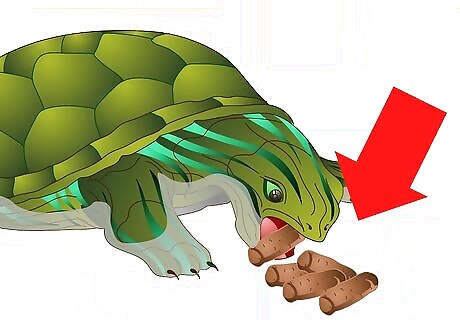
Be aware that turtles are generally omnivorous. Yes, turtles will eat or try to eat just about anything you put near them. In captivity, some species eat turtle pellets, which often include shrimp or fish meal, flour, and vitamin supplements. Dietary preference vary a bit by species, however.

Consider red-eared sliders. These are a popular pet species. They are usually pretty carnivorous, but they can eat aquatic plants and vegetables, ideally floating ones. Preferable vegetables include dark romaine leaves, mustard or collard greens, endive, Swiss chard, kale, parsley, and carrot tops. In captivity, they eat turtle pellets. As they grow older, they tend to eat more plant matter, but bear in mind that younger turtles eat more animals.

Look into western painted turtles. They eat aquatic plants, crickets, earthworms, insect larvae, and commercial pet food. They can also eat chopped fish, but this is not recommended since you don’t want your turtle to develop a taste for fish if you plan on introducing live fish to their habitat. So, be careful keeping crustaceans around.

Research other turtle species as pets. There are other turtles that might be good pets, but bear in mind that they might not be able to cohabitate with fish. Map turtles are primarily carnivorous. So, they’re not suitable tank mates for fish. Box turtles are also popular, but since they’re not aquatic per se, you obviously wouldn’t be pairing fish with them.
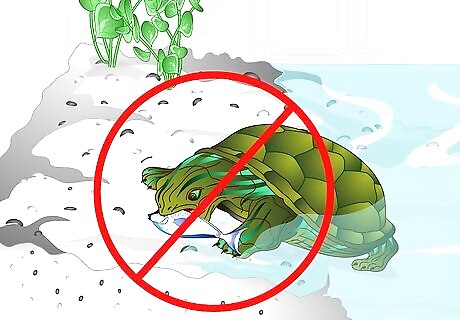
Don't feed the turtle feeder guppies or feeder fish. On a fish diet, your turtle may be more inclined to try to eat any other fish that might be in the tank. So, you do not want your turtles to get in the habit of eating fish, particularly live fish.
Choosing Fish Companions
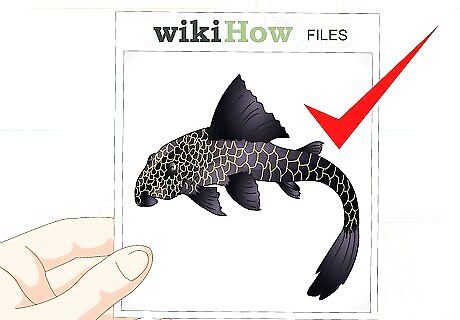
Look into hearty fish species primarily. Since turtles are rather omnivorous and apt to consider other animals as potential food, the heartier fish species you can find, the better. Just make sure it’s not so hearty as to be aggressive. Plecostomus is a hearty category of fish. Plecos (the common name for plecostomus), aka a sucker fish, is a fish in the catfish group that are popular pets. Plecos are algae eaters of varying colors. Some can grow to be two feet long in a large tank. Many of them also have armor. So, most turtles, even adults, don’t seriously injure them. Certain large fish can be turtle companions. In addition to sucker fish, certain large koi can cohabitate with turtles such as red ear sliders. Bear in mind, however, that the turtles may nip at their fins.

Account for turtle size. Remember that most semi-aquatic turtles can grow very large very quickly. So, take future turtle size into account when choosing a fish. Unless a fish is particularly fast and agile, it’s better to have any fish be larger than the turtle or as large as possible. Giant gourami and cichlids might also be suitable fish in a turtle tank. Giant gourami are large enough that they might not be considered turtle food. Non-aggressive types of cichlids are also potentially good mates. Small and fast fish can survive in turtle tanks. Tiny and agile fish such as guppies may be able to cohabitate with turtles. Beware of them overpopulating the tank, though.
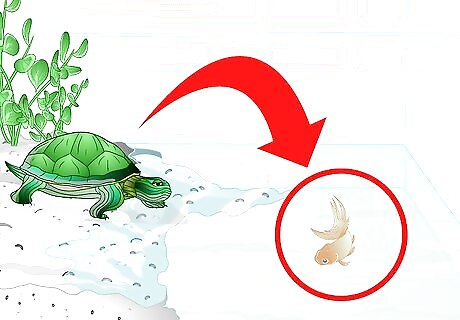
Research other options if you have difficulty finding a suitable mate. It’s not always easy finding a suitable tank mate for a turtle, and your pet store’s options might also limit your own. So, some aquarists use small and common fish, which might be suitable companions for a time. Some turtle owners place goldfish and minnows in turtle tanks. They may survive, and tend to have a short lifespan anyway. If the turtle does eat them, however, they are inexpensive and easily replaceable. Ghost shrimp are also a potential short-term option. If they have enough hiding spaces and cover in the tank, ghost shrimp can have a respectable survivability rate. Some may be eaten, however, and ghost shrimp don’t have a long natural lifespan as it is. Consider apple snails as an alternative. If you are getting fish to eat algae, consider buying apple snails instead. Get the largest ones possible and they should be safe in the tank, unless you have a 2 foot (0.6 m) long turtle.
Introducing Fish to the Turtle Habitat
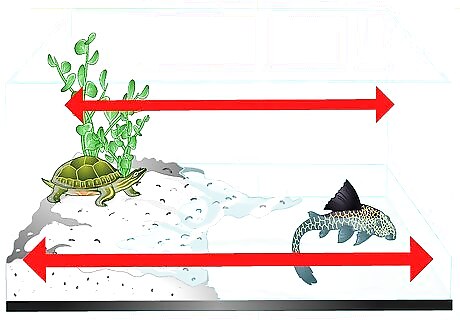
Make sure the turtle habitat is large enough. Since pet turtles can grow large, you’ll want to accommodate them—and any fish companions—with a large tank. A five-foot-long tank at a volume of 80 gallons is recommended.
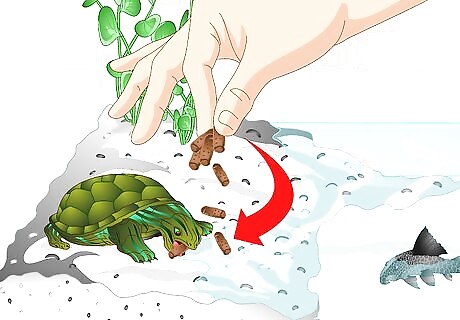
Feed the turtle immediately before introducing a new fish. This is important for obvious reasons. If the turtle isn’t hungry when the fish is introduced, it is less likely to go after the fish immediately as a source of food. It is also likely to have a better temperament and be less shocked by the introduction of a new tank mate.

Introduce the fish when the turtle is mature. Lots of adult semi-aquatic turtles (like red ear sliders) eat more vegetables as adults. So, they are less likely to consider the fish as a potential meal. When the turtle is mature, you’ll also know its adult size. This way, you can see what size companion might be suitable for the turtle, if you’re considering a large fish .

Watch the fish carefully after introduction. See if the turtle reacts to the fish's presence. If there is no reaction, you may be okay having the sucker fish in the tank with the turtle. If the turtle swims up to the fish and nips at it or keeps bothering it, you should remove the fish and find it a new home (or return it to the store).
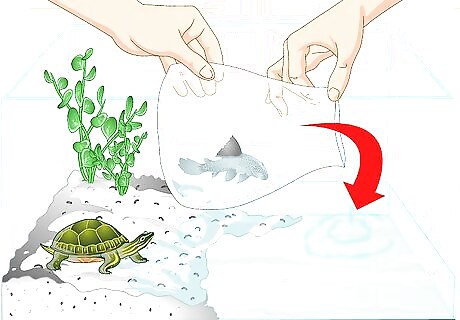
Acclimatize the fish to the water. Water chemistry can differ considerably between fish tanks. So, slowly introduce the fish to the tank by first floating it in its bag in the tank for 5 minutes, then adding a little bit of the tank water to the bag every 5-10 minutes until the water in the bag is twice the volume it was before. Carefully, take out half the water in the fish bag and again add a little tank water at a time every 5 minutes until the water in the bag is again doubled. Wait five minutes, then carefully net the fish (or pour the contents of the bag over a sink into a clean colander that has no soaps or chemical residue) and put the fish gently into the tank. Using this transition method, the fish will adapt more gradually to the change in temperature, pH, GH, etc., and will be more likely to survive the transition.
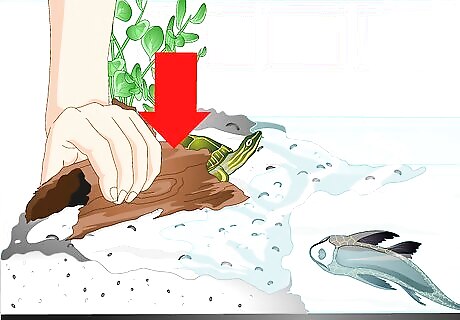
Include hiding spots in the tank. These will allow the fish to have space to themselves, to feel less stressed, and to be less vulnerable to the turtles. Hiding spots can also add decoration to the tank, while providing segmentation that gives different species their own different regions of the tank. Terracotta flowerpots and PVC piping are usually ideal. These have a less natural look but can be easily accessible to fish, while impenetrable to turtles. Also, many are made especially for aquariums, including related ornaments like miniature sunken ships. Bushy plants can provide good hiding spots. Synthetic plants made especially for fish tanks are best. You don’t want the turtle to eat any plants meant to hide or protect your fish. Rocks and driftwood can work when chosen carefully. Rocks are good hiding spots for fish, but make sure they’re not too heavy for the aquarium or too light for the turtle to move. The same applies to driftwood, but also make sure the wood has been treated for use in aquariums so that it doesn’t release any toxins.

















Comments
0 comment